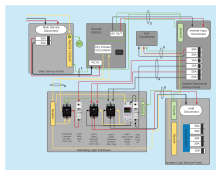Yep - the ground conductor from the Main Service Panel to the Inverter Disconnect Service Panel is simply because calculation of ground fault current can't be done accurately because - if we were to wire the ground
through the GW, we don't know the ampacity because it isn't documented. Also, the fewer connections (lugs, terminals, etc) on our grounding conductor, the less chance of something working loose and compromising the fault current needed to trip an OCPD.
It could be argued that we should run
two grounds:
- Main Service Panel --> Inverter Disconnect Service Panel
- Main Service Panel --> Inverter Load Service Panel
Instead of in the daisy-chain format I have in the diagram, which is:
- Main Service Panel --> Inverter Disconnect Service Panel
- Inverter Disconnect Service Panel --> Inverter Load Service Panel
I could definitely be convinced to use the latter of the two approaches if anybody feels that'd be more code-compliant/safe.
As for fault current calculations, that's the next step that needs taken when it comes to conductor ampacity and conduit BOMs. If anybody wants to take a swing at that, please go ahead. Otherwise I'll try this weekend.
I'm also considering extending this wiring diagram to have dual over/under voltage protection relays - one for each leg of the AT. This provides an additional layer of redundancy in our neutral safety circuit.
One thing the
most recent design doesn't have is the ability to detect loss of G/N bonding when running in off-grid mode. If anybody has suggestions on detection for this, please say so.






